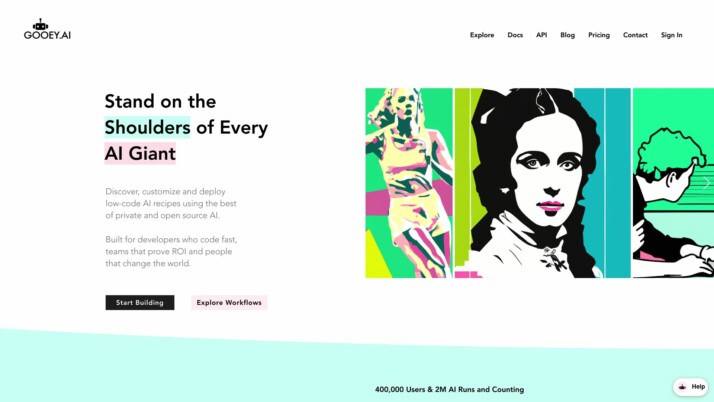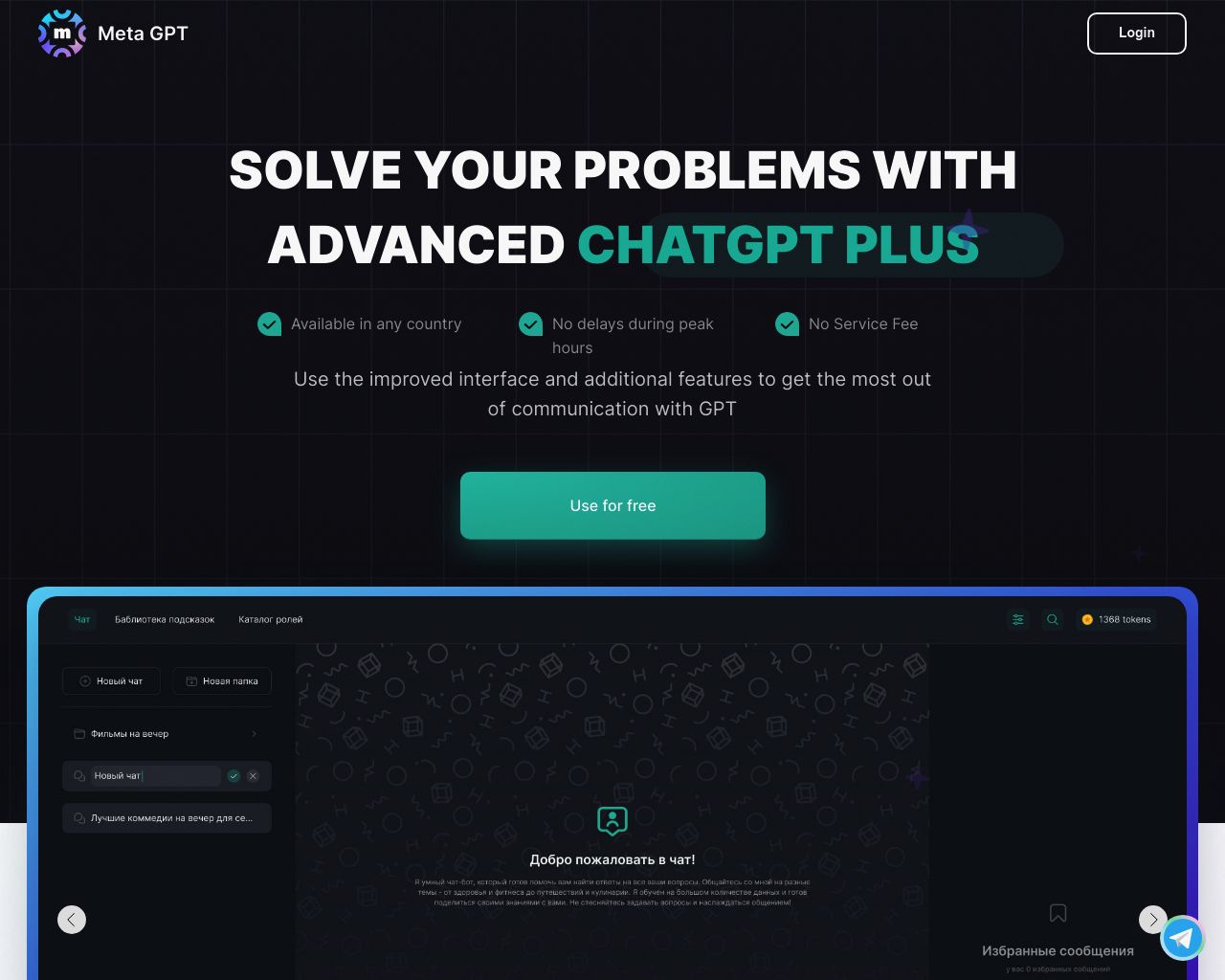Gooey AI vs. MetaGPT: Comparing AI Agent Platforms
AI agent development platforms are revolutionizing how businesses harness artificial intelligence. Gooey AI vs. MetaGPT offer unique approaches to this challenge, each with distinct strengths. Gooey AI provides a user-friendly interface for building AI copilots and chatbots, while MetaGPT simulates software development processes with specialized AI roles. This comparison examines how these platforms stack up against SmythOS, a comprehensive solution that combines intuitive design with powerful customization. We’ll explore key features, security measures, and integration capabilities to help developers, business leaders, and AI enthusiasts make informed decisions about the best platform for their AI agent needs.
Gooey AI Overview
Gooey AI empowers users to build sophisticated AI copilots and chatbots without extensive coding knowledge. The platform integrates multiple large language models, including OpenAI’s GPT series and Google’s PaLM, to create versatile conversational agents.
Gooey AI’s no-code interface simplifies the creation of AI workflows, making advanced AI capabilities accessible to developers and non-technical users alike. The platform excels in natural language processing tasks, enabling AI agents to understand context, maintain conversation history, and provide relevant responses.


Screenshot of Gooey AI Website
Gooey AI’s no-code interface simplifies the creation of AI workflows, making advanced AI capabilities accessible to developers and non-technical users alike.
Key features include document processing with OCR capabilities, multimodal support for text, audio, and video interactions, and integration with popular communication platforms like Slack and WhatsApp. Gooey AI also offers Retrieval Augmented Generation (RAG) to enhance response accuracy by searching through indexed domain-specific documents.
While Gooey AI provides a robust set of tools for AI development, it may have limitations in areas like extensive customization for highly specialized use cases or advanced debugging tools for complex AI workflows. The platform’s strength lies in its ability to quickly deploy functional AI solutions, but users seeking granular control over AI model parameters might find some constraints.
Gooey AI positions itself as a versatile solution in the AI chatbot and automation market, catering to a wide range of industries from customer support to data analysis. Its focus on combining private and open-source AI technologies aims to democratize AI development, making it an attractive option for businesses looking to leverage conversational AI without significant technical overhead.
MetaGPT Overview
MetaGPT revolutionizes multi-agent collaboration in software engineering. This open-source framework combines human Standardized Operating Procedures (SOPs) with advanced Large Language Models (LLMs) to simulate a software company’s operations.


MetaGPT assigns distinct roles to AI agents, mirroring a traditional software company structure. Product managers, architects, engineers, and QA testers collaborate efficiently using SOPs encoded into prompt sequences. This approach, summarized as “Code = SOP(Team),” integrates established human practices into AI-driven processes, enhancing output consistency and reliability.
MetaGPT assigns distinct roles to AI agents, mirroring a traditional software company structure… This approach… integrates established human practices into AI-driven processes
The platform excels in breaking down complex tasks into manageable subtasks handled by specialized agents. This assembly line paradigm ensures each agent contributes its expertise, resulting in more accurate and robust solutions. MetaGPT generates comprehensive documentation throughout the development process, including requirement documents, design artifacts, and interface specifications.
While MetaGPT offers powerful collaboration tools, it may present a learning curve for users unfamiliar with software development processes. The open-source nature of the platform provides flexibility but could require additional setup and maintenance compared to fully-managed solutions.
MetaGPT integrates with various foundation AI models like OpenAI GPT and Google PaLM, enabling developers to leverage cutting-edge language models. The platform supports deployment of AI solutions as APIs and webhooks, facilitating integration with existing systems and workflows.
In the competitive landscape of AI agent builders, MetaGPT stands out for its software development focus and emphasis on structured collaboration. While it may not offer the same level of no-code tools as some alternatives, its unique approach to mimicking human teamwork in AI development provides a powerful solution for complex software engineering tasks.
Feature Comparison
Gooey AI and MetaGPT offer distinct approaches to AI agent development, with notable differences in their core components and security features. Gooey AI provides a user-friendly no-code interface for building AI copilots and chatbots, emphasizing ease of use for non-technical users. Its multimodal capabilities support text, audio, and video interactions, enabling versatile AI solutions across various communication channels. In contrast, MetaGPT focuses on simulating software development processes, assigning specialized roles to AI agents to mimic a software company’s structure.
Security-wise, Gooey AI implements standard practices like data encryption and OAuth authentication, ensuring secure API integrations. MetaGPT, being an open-source framework, relies more on user-implemented security measures. This difference highlights Gooey AI’s advantage in providing built-in security features, potentially making it more suitable for enterprise-level deployments where data protection is paramount.
In terms of core components, Gooey AI offers integration with multiple foundation AI models, including OpenAI’s GPT series and Google’s PaLM. It also supports various APIs and RPA tools, enhancing its versatility. MetaGPT, while powerful in its approach to software development simulation, may lack the same level of pre-built integrations and user-friendly tools for rapid AI deployment. This gap underscores Gooey AI’s strength in providing a more accessible platform for users seeking quick implementation of AI solutions across diverse business contexts.
Feature Comparison Table
| Gooey AI | MetaGPT | SmythOS | |
|---|---|---|---|
| CORE FEATURES | |||
| Visual Builder | ✅ | ❌ | ✅ |
| No-Code Options | ✅ | ❌ | ✅ |
| SECURITY | |||
| IP Control | ❌ | ❌ | ✅ |
| COMPONENTS | |||
| Zapier APIs | ❌ | ✅ | ✅ |
| Data Lakes | ❌ | ❌ | ✅ |
| DEPLOYMENT OPTIONS (EMBODIMENTS) | |||
| Staging Domains | ❌ | ❌ | ✅ |
| Production Domains | ❌ | ✅ | ✅ |
| DATA LAKE SUPPORT | |||
| Hosted Vector Database | ✅ | ❌ | ✅ |
| Sitemap Crawler | ❌ | ❌ | ✅ |
| YouTube Transcript Crawler | ✅ | ❌ | ✅ |
Best Alternative to Gooey AI and MetaGPT
SmythOS stands out as the superior alternative to Gooey AI and MetaGPT, offering a comprehensive platform for AI agent development and deployment. Our drag-and-drop interface simplifies the creation of complex AI workflows, making advanced AI capabilities accessible to users with varying levels of technical expertise. We provide extensive integration options, connecting with popular services and supporting multiple AI models from providers like OpenAI, Anthropic, and Hugging Face.
SmythOS stands out as the superior alternative to Gooey AI and MetaGPT, offering a comprehensive platform for AI agent development and deployment.
Unlike Gooey AI and MetaGPT, SmythOS offers a more versatile approach to AI agent development. While Gooey AI focuses on building AI copilots and chatbots, and MetaGPT simulates software development processes, we enable users to create a wide range of AI solutions, from chatbots to complex multi-agent systems. Our platform supports autonomous agents that can perform tasks independently, interact with APIs, and collaborate with other agents, surpassing the capabilities of both competitors.
In terms of ease of use, SmythOS outshines both Gooey AI and MetaGPT. Our visual builder and no-code options make AI development accessible to non-technical users, while still providing the depth and flexibility required by experienced developers. This approach democratizes AI creation, allowing businesses of all sizes to leverage advanced AI technologies without the need for specialized expertise.
Our visual builder and no-code options make AI development accessible to non-technical users, while still providing the depth and flexibility required by experienced developers.
Security and scalability are paramount in SmythOS. We offer robust security features, including data encryption, OAuth authentication, and IP control, addressing enterprise-level concerns that may not be fully addressed by open-source frameworks like MetaGPT. Our platform is designed to scale seamlessly, supporting everything from small-scale prototypes to large-scale enterprise deployments, ensuring that our solution can grow with your needs.
With SmythOS, we’ve created a platform that combines the best of both worlds – the accessibility of no-code solutions like Gooey AI and the power of advanced AI frameworks like MetaGPT. Our comprehensive feature set, including support for multimodal interactions, problem-solving capabilities, and advanced deployment options, positions SmythOS as the ideal choice for businesses and developers looking to harness the full potential of AI technology.
Conclusion
Gooey AI and MetaGPT offer unique approaches to AI agent development, each with distinct strengths. Gooey AI excels in user-friendly, no-code AI copilot creation, while MetaGPT simulates software development processes with specialized AI roles. Both platforms provide valuable tools for different user needs, but SmythOS emerges as the superior choice for comprehensive AI agent development and deployment.
SmythOS combines the best of both worlds, offering an intuitive drag-and-drop interface for non-technical users and powerful customization options for developers. Our platform’s extensive integration ecosystem, supporting over 300,000 integrations, surpasses the capabilities of both Gooey AI and MetaGPT. SmythOS enables seamless connection to various data sources, APIs, and AI models, making it adaptable to diverse business requirements.
Unlike Gooey AI’s focus on chatbots or MetaGPT’s emphasis on software development simulation, SmythOS provides a versatile environment for creating and deploying AI agents across multiple platforms. Our ’Create Once, Deploy Anywhere’ approach allows users to build agents that integrate effortlessly into various environments, from chat interfaces to APIs and scheduled tasks. This flexibility, combined with robust security features and scalability, makes SmythOS the ideal choice for businesses seeking to leverage AI across their operations.
To experience the power and versatility of SmythOS, we invite you to explore our diverse range of AI-powered agent templates. These templates cover multiple business categories and offer a starting point for streamlining processes across various functions. For those ready to dive in, you can create a free SmythOS account and start building AI agents with no time limit or risk. Unleash the potential of AI for your business and join the future of workforce automation with SmythOS.
Last updated:
Disclaimer: The information presented in this article is for general informational purposes only and is provided as is. While we strive to keep the content up-to-date and accurate, we make no representations or warranties of any kind, express or implied, about the completeness, accuracy, reliability, suitability, or availability of the information contained in this article.
Any reliance you place on such information is strictly at your own risk. We reserve the right to make additions, deletions, or modifications to the contents of this article at any time without prior notice.
In no event will we be liable for any loss or damage including without limitation, indirect or consequential loss or damage, or any loss or damage whatsoever arising from loss of data, profits, or any other loss not specified herein arising out of, or in connection with, the use of this article.
Despite our best efforts, this article may contain oversights, errors, or omissions. If you notice any inaccuracies or have concerns about the content, please report them through our content feedback form. Your input helps us maintain the quality and reliability of our information.
